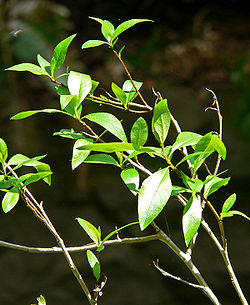Populus angustifolia
- Populus angustifolia
-
Peuplier à feuilles étroites
Le Peuplier à feuilles étroites (Populus angustifolia) est une espèce de peuplier présente dans la partie occidentale d’Amérique du Nord. Il est apparenté au peuplier baumier.
Nom
Le peuplier à feuilles étroites est aussi connu sous le nom de liard amer et de peuplier angustifolié[1].
Description
Ses feuilles sont vertes jaunâtres de forme lancéolée. Les chatons sont duveteux et blancs. Ses boutons sont mous et collants ce qui fait qu’ils étaient consommés par les Amérindiens comme une sorte de chewing gum.
Habitat
L’arbre est présent dans la partie occidentale de l’Amérique du Nord du Canada (Alberta et Saskatchewan) jusqu’au Mexique. On le trouve généralement à proximité de cours d’eau dans des régions d’altitudes élevées[2].
Voir aussi
Liens externes
Notes et références
- ↑ John Laird Farrar, Les Arbres du Canada, Fides, Ottawa, 1996, 502 p. (ISBN 2-7621-1824), p. 342
- ↑ (en) Profil de la Plante sur USDA, 2009, USDA. Consulté le 13-7-2009
 Portail de la botanique
Portail de la botanique
Wikimedia Foundation.
2010.
Contenu soumis à la licence CC-BY-SA. Source : Article Populus angustifolia de Wikipédia en français (auteurs)
Regardez d'autres dictionnaires:
Populus angustifolia — Scientific classification Kingdom: Plantae (unranked) … Wikipedia
Populus angustifolia — Cottonwood Cot ton*wood ( w[oo^]d ), n. (Bot.) An American tree of the genus {Populus} or poplar, having the seeds covered with abundant cottonlike hairs; esp., the {Populus monilifera} and {Populus angustifolia} of the Western United States.… … The Collaborative International Dictionary of English
Populus angustifolia — ID 66880 Symbol Key POAN3 Common Name narrowleaf cottonwood Family Salicaceae Category Dicot Division Magnoliophyta US Nativity Native to U.S. US/NA Plant Yes State Distribution AZ, CA, CO, ID, MT, NE, NM, NV, OR, SD, TX, UT, WY Growth Habit Tree … USDA Plant Characteristics
Populus angustifolia James — Symbol POAN3 Common Name narrowleaf cottonwood Botanical Family Salicaceae … Scientific plant list
Populus sect. Tacamahaca — This article is about the various species in Section Tacamahaca of the poplar genus (Populus). For the balsam poplar of eastern and northern North America, see Populus balsamifera. For other kinds of balsam, see balsam. Populus sect. Tacamahaca… … Wikipedia
Populus — Pappeln Kanadische Pappel (Populus canadensis) Systematik Abteilung: Bedecktsamer (Magnoliophyta) … Deutsch Wikipedia
Populus — Taxobox name = Populus image width = 240px image caption = Foliage of Populus tremula regnum = Plantae divisio = Magnoliophyta classis = Magnoliopsida ordo = Malpighiales familia = Salicaceae genus = Populus genus authority = L. subdivision ranks … Wikipedia
Populus — Para otros usos del término, véase Alameda, Álamo (desambiguación) o Chopo (desambiguación) Álamo … Wikipedia Español
Populus monilifera — Cottonwood Cot ton*wood ( w[oo^]d ), n. (Bot.) An American tree of the genus {Populus} or poplar, having the seeds covered with abundant cottonlike hairs; esp., the {Populus monilifera} and {Populus angustifolia} of the Western United States.… … The Collaborative International Dictionary of English
Populus — Peuplier Peuplier … Wikipédia en Français



